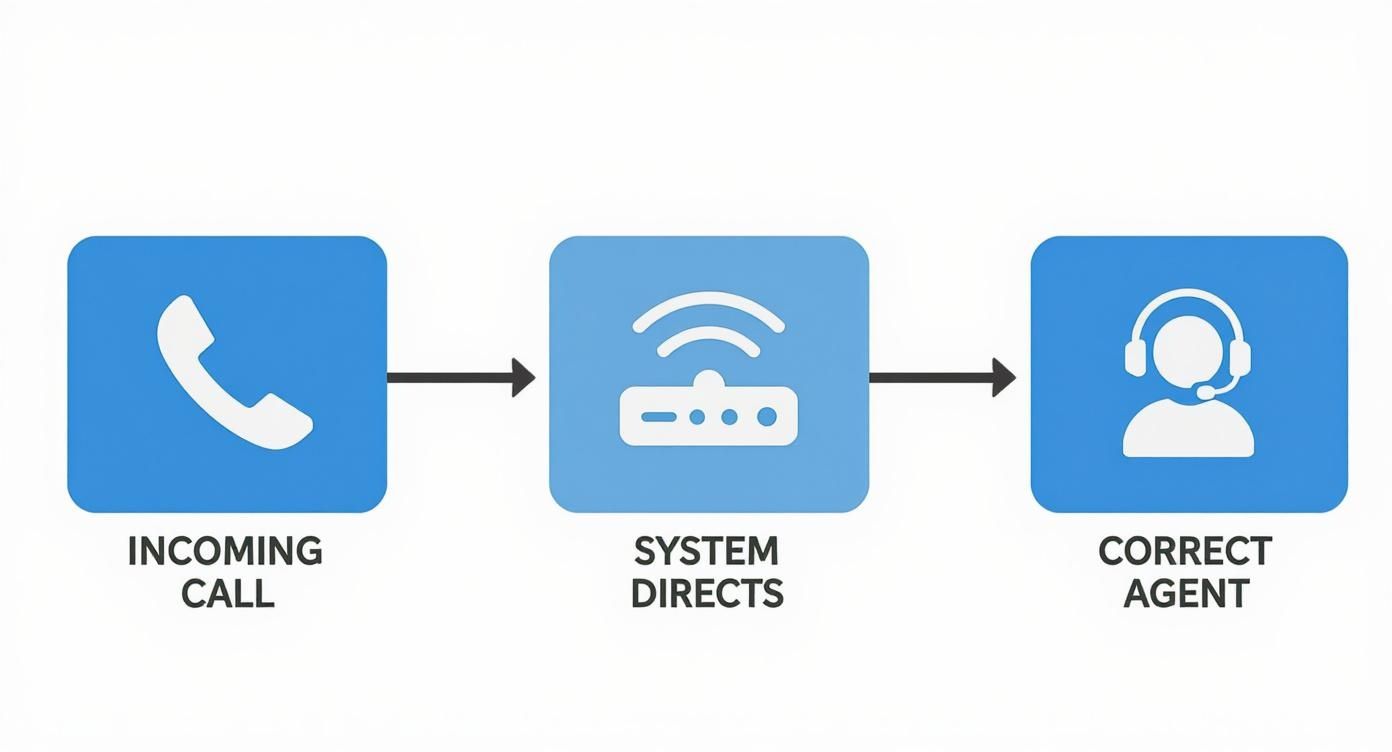Think of call routing as the air traffic control for your business phone line. It’s the behind-the-scenes magic that automatically sends incoming calls to the right person or department based on rules you set. The goal is simple: get your callers the help they need, right away.
Imagine your business phone is a busy airport. Without air traffic control, every incoming flight—your customer calls—would try to land on the same runway. It would be chaos. Long lines, frustrated travelers, and a ton of confusion. That's exactly the problem call routing solves. It acts like a brilliant, always-on switchboard operator, directing every call to its perfect destination without a single manual handoff.
This system takes the place of a human receptionist having to manually transfer every single call, a task that’s not only slow but also ripe for mistakes. Instead, an automated process instantly figures out where the call needs to go and sends it down the correct path.
This isn't just about efficiency; it's about meeting customer expectations head-on. A stunning 77% of consumers expect an immediate interaction when they contact a business. Call routing is the core technology that makes this happen.
At its heart, call routing is about creating a smoother, faster experience for everyone involved—your customers and your team. Instead of letting every call pile up in one big inbox, the system sorts them intelligently from the get-go. This simple act of organization has a massive ripple effect across your entire business.
For a clearer picture, here’s a quick breakdown of what we're talking about.
These core ideas are the building blocks for creating a professional and streamlined communication flow that works for you, not against you.
Here’s what that looks like in action:
By guiding callers to the right person on the first try, businesses can slash transfer rates, shorten hold times, and nail that all-important first-call resolution. It turns a potentially messy phone line into a well-oiled machine.
To really get what call routing is, let's trace the path of a single phone call. Picture a customer dialing your business number. The second they do, a smart system kicks into gear. This system, often called an Automatic Call Distributor (ACD) or an Interactive Voice Response (IVR), acts like a digital traffic controller, guiding the call exactly where it needs to go.
This isn't just about patching one line to another; it's a finely tuned process built for speed and precision. The system immediately checks out the incoming call, figures out who is calling (if it can), and starts running through a list of pre-set rules to decide the best next move.
First things first, the system has to qualify the call. As soon as the connection is made, its job is to figure out what the caller wants. This is where you typically run into an IVR menu prompting you to "Press 1 for Sales, Press 2 for Support."
More sophisticated systems might use natural language processing to just ask, "How can I help you today?" and understand what you say back. Think of it like a receptionist asking a visitor who they're there to see before pointing them down the right hallway. This quick interaction gathers all the info needed to make a smart routing decision.
This simple infographic breaks down the basic flow from the moment a call comes in to when it reaches the right person.

As you can see, the system acts as a central hub, preventing a chaotic free-for-all by directing traffic where it belongs.
Once the system knows what the caller needs, it moves on to queuing and distribution. It basically pulls out its rulebook, which could have instructions like:
The system then transfers the call to the best destination—a specific department, an individual, or even a pre-recorded message. The whole thing happens in seconds, making the experience feel totally seamless for the caller.
The demand for this kind of efficiency is why the global call routing software market, currently valued at around $5 billion, is projected to grow at a 15% CAGR. As more businesses move to cloud-based communication, this technology is becoming essential. You can explore more data on call routing software market growth to see the full picture.
At its heart, a call routing system is all about translating a caller's intent into an action. It uses predefined logic to make sure every single call lands exactly where it needs to go, with as little delay or frustration as possible.
Once you have a grip on what call routing is, the real question becomes: which playbook do you run? Because not every routing strategy fits every business. Picking the right one is like choosing the right tool for a job—you wouldn't bring a hammer to a screw, and the same logic applies here.
Different strategies are built to solve different problems, whether that’s dealing with after-hours calls, making sure work is distributed fairly, or connecting a customer with a genuine expert on the first try. When you match the routing method to your actual business goals, you end up with a system that just works—for you and your customers.
Picture this: a customer calls your support line at 9 PM on a Friday. Without time-based routing, that call just rings and rings in a dark, empty office. This strategy is your 24/7 gatekeeper, directing calls based on the time of day, day of the week, or even specific holidays so you never leave a customer hanging.
During business hours, calls go right to your main team. But after hours or on weekends? They can be smartly sent to:
This method is a lifesaver for any business that needs to manage calls around the clock without having staff physically chained to their desks.
Have you ever been stuck in that dreaded customer service loop, getting transferred from person to person because nobody seems to have the right answer? That’s the exact problem skills-based routing was designed to fix. It’s all about getting the caller to the one person best equipped to handle their specific issue, paving a direct path to first-call resolution.
The system figures out what the caller needs—usually through a quick IVR menu—and matches them with an agent who has the right expertise. For instance, a caller with a tricky software question gets sent straight to a product specialist, not a billing agent. Someone who selects Spanish on the menu is instantly connected with a bilingual team member.
This simple change can completely transform the customer experience. Instead of bouncing between departments, callers connect with an expert who can solve their problem right away. That efficiency doesn't just cut down on frustration; it builds real trust in your brand.
When your main goals are keeping things fair and running at peak efficiency, two methods really shine: Round-Robin and Least-Occupied routing. Both are fantastic for managing call volume and preventing your team from burning out, but they get there in slightly different ways.
Round-Robin Routing is all about equal distribution. It passes out calls evenly across the team in a fixed loop. If you have three agents—Anna, Ben, and Chloe—the first call goes to Anna, the second to Ben, the third to Chloe, and the fourth circles right back to Anna. It's the perfect setup for sales teams where you need to ensure everyone gets a fair shot at new leads.
Least-Occupied Routing, on the other hand, is built for pure productivity. It sends the next incoming call to the agent who has been idle the longest or has handled the fewest calls that day. This keeps your entire team engaged and dramatically cuts down on customer wait times, making it a go-to choice for high-volume support centers where every second counts.
Choosing the right strategy can feel daunting, but it really comes down to your primary business goal. Are you focused on fairness, speed, customer experience, or 24/7 availability? This table breaks down the core strengths of each method to help you decide.
Ultimately, the best approach aligns with how your team operates and what your customers expect. By understanding these fundamental strategies, you can build a communication system that not only works but actively helps your business grow.
If traditional call routing is like a train following a single, fixed track, then adding Artificial Intelligence (AI) is like giving the train an intelligent GPS that reroutes the entire network in real-time. AI completely overhauls the old "if-then" logic, creating a proactive system that anticipates where a caller needs to go, often before they even know it themselves.
Instead of boxing customers into rigid IVR menus ("Press 1 for Sales, Press 2 for Support..."), AI-powered systems use Natural Language Processing (NLP) to simply listen. A customer can say, "I need to check on my last order," and the AI gets it. It understands their intent and routes them to the right person, no button-pushing required.

This shift is a huge reason why the call center AI market was valued at $2.1 billion and is still climbing. By automating complex routing decisions, AI-enhanced systems cut down on wait times, reduce operational costs, and just plain work better.
The real magic of AI isn't just in understanding what a person says; it's in predicting what they need. It chews through massive amounts of data—past calls, CRM notes, even the caller's tone of voice—to make smarter decisions on the fly.
For instance, an AI can use sentiment analysis to detect frustration or urgency. If it picks up on a highly agitated customer, it can instantly escalate that call to a senior manager or a specialist trained in de-escalation. It's about solving a problem before it blows up.
AI routing doesn't just connect calls; it understands the context behind them. It prioritizes high-value clients, identifies urgent issues, and even anticipates a caller's needs, creating a truly seamless interaction.
This isn't just theory—businesses are seeing real results from this technology today. Imagine an AI system that can:
The engine powering this shift is the modern AI phone agent. These systems are what make intelligent, next-generation call routing accessible for businesses of any size. By bringing AI into the mix, call routing stops being a simple switchboard and becomes a strategic tool for delighting customers and growing the bottom line.
Putting a call routing system in place does a lot more than just organize your phone calls—it can fundamentally change the way you do business. When you get every caller to the right person on the first try, you’re cutting out friction and frustration. You're creating a professional, seamless experience right from the get-go. And that efficiency has a real, measurable impact on your bottom line.
Think about the customer's journey. Instead of getting stuck in a long queue or bounced from one department to another, they connect with someone who can actually help them. This quick connection dramatically improves first-call resolution rates, which is a huge driver of customer loyalty.
Beyond making customers happier, a smart routing strategy just makes sense for your team. It protects them from having to field calls they aren't equipped to handle, letting them focus on the work where they truly make an impact. That means fewer unnecessary transfers and more time back in their day.
This jump in productivity translates directly into cost savings. When your team spends less time playing switchboard operator and more time solving problems, your operational costs naturally drop. For businesses looking to sharpen their communications and save money, exploring Hosted VirtualPBX solutions is a great place to start.
A call routing system isn't just a utility; it's a strategic asset. It makes sure your most valuable resources—your people—are used effectively. It turns your phone line into a tool for growth instead of a source of chaos.
One of the biggest—and often overlooked—benefits is the mountain of data you suddenly have access to. Modern call routing systems give you a clear window into critical metrics, helping you make smarter, data-backed decisions about how your business runs.
What kind of insights are we talking about?
This level of insight is pure gold. It's no wonder the market for this technology is booming. The call routing software market, recently valued at around $2.1 billion, is projected to rocket past $5.8 billion in the next decade. That growth tells you just how essential this tech has become for businesses of all sizes. You can discover more insights about call routing software market trends to get the full picture.
Alright, let's move from theory to action. This is where the magic really happens—when you see how a well-thought-out call routing plan can genuinely change how your business operates. Implementing your first system isn't about just flipping a switch; it's a deliberate process that starts with knowing exactly what you want to achieve. A solid setup can turn your phone line from a simple point of contact into one of your most powerful business tools.
This roadmap will help you turn that abstract knowledge into a concrete plan, making sure your system is built for success from the get-go.

Before you even think about the technology, you have to start with the "why." What specific headaches are you trying to cure with call routing? Getting crystal clear on your objectives will be your North Star for every decision that follows, from the software you pick to the rules you program into it.
Most businesses are trying to solve one of these common problems:
Once you know where you're headed, you can start drawing the map to get there.
Next up, put yourself in your customer's shoes. Why are they calling you in the first place? If you don't understand their intent, you risk building a system that feels like a maze instead of a helpful guide.
Think about the main reasons people call. Is it to buy something? Ask a technical question? Check on an order status? Maybe dispute a bill? Each of these is a distinct path your routing system needs to handle.
Mapping these common journeys is how you design logical IVR menus and skill-based agent groups. The goal is to guide callers to the right person or answer so effortlessly they don't even notice the system behind it.
With your goals and customer paths clearly defined, you can finally start looking at the tools. You'll want to find a VoIP provider or an AI receptionist service, like My AI Front Desk, that offers the features you need—think IVR, skills-based routing, and maybe even CRM integrations.
Once you’ve picked your platform, it’s time to bring your strategy to life by building and testing the rules. I always recommend starting simple. Configure your business hours, set up a few basic agent groups, and record your main IVR greetings. Then, run a bunch of test calls to make sure every path works exactly as you planned. Tweak and adjust until the experience is completely seamless.
Still have a few questions floating around about call routing and how it actually works in a real business? You're not alone. Let's tackle some of the most common ones to give you the full picture.
It's a common mix-up, but they're fundamentally different tools for different jobs.
Think of call forwarding like a simple "mail forwarding" sticker you put on your mailbox. It’s a one-to-one redirect. Every call that comes to one number gets automatically punted to another, single number. Simple, but not very smart.
Call routing, on the other hand, is the intelligent traffic controller for your phone system. It’s a dynamic setup that can send calls to multiple people or departments based on a whole set of rules you create—like the time of day, who's available, or what the caller is actually asking for. It's strategic, not just a simple hand-off.
Hands down, it's about looking professional and running efficiently. For a small business, creating the impression of a larger, well-oiled machine is a massive step toward building customer trust and confidence.
Call routing is what stops you from losing a hot lead just because they called after 5 PM. It also ends the chaos of every phone in the office ringing at once, letting your team stay focused on their work instead of playing receptionist.
When you start looking at different call routing systems, you need to think beyond a simple digital switchboard. The goal is to find a tool that brings both flexibility and a bit of brains to the table.
Here are the features that really matter:
These aren't just bells and whistles; they're the features that turn a basic phone line into a powerful engine for customer happiness and business growth.
Ready to see how an AI-powered system can completely change your business communications? My AI Front Desk offers intelligent call routing, appointment scheduling, and lead conversion tools built specifically for small businesses like yours. Learn more and get started today at myaifrontdesk.com.
Start your free trial for My AI Front Desk today, it takes minutes to setup!








